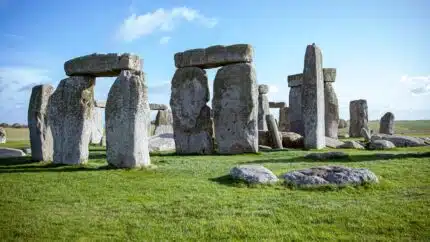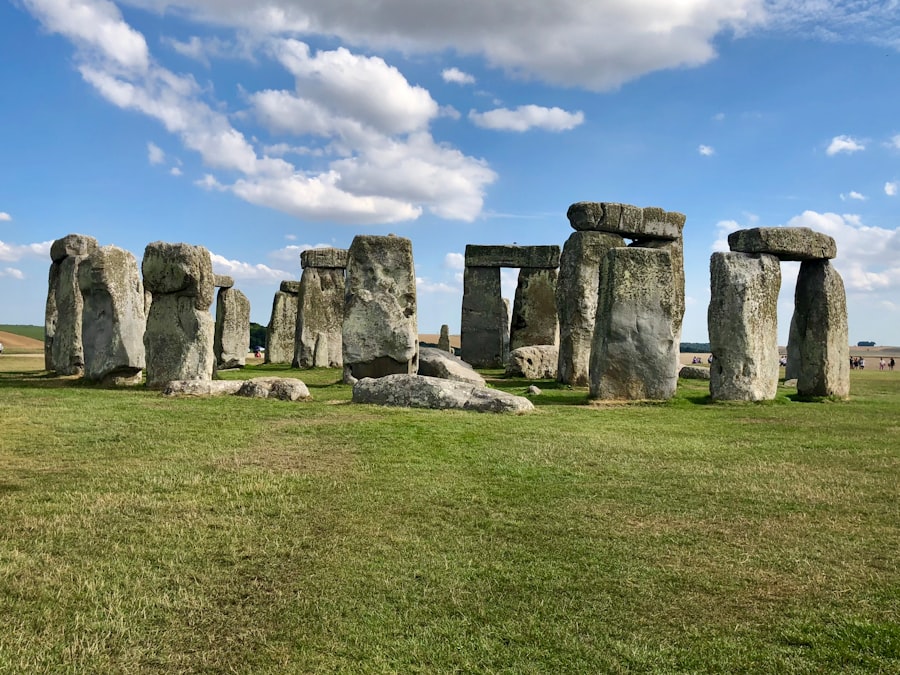Stonehenge: Cracking the Code Behind England’s Megalithic Monument

Stonehenge, located in Wiltshire, England, is one of the most perplexing and mysterious ancient monuments in the world. Despite years of research and study, many questions about its purpose and construction remain unanswered. The monument consists of a circular arrangement of large standing stones, some weighing up to 50 tons. It is believed to have been built in several stages over a period of 1,500 years, from around 3000 BC to 1600 BC. Stonehenge has captivated the imagination of people for centuries, and its enigmatic nature continues to intrigue researchers and visitors alike.
The History of Stonehenge: From Its Creation to Present Day
The history of Stonehenge spans thousands of years, with evidence of human activity in the area dating back to around 8000 BC. However, the construction of the monument as we know it today began around 3000 BC. It was built in several stages, with each phase adding to the complexity and grandeur of the structure.
Stonehenge was used for various purposes throughout its history. It served as a burial ground, with human remains found in and around the monument. It was also used for religious ceremonies and astronomical observations. The alignment of the stones with the solstices and equinoxes suggests a connection to astronomy and the stars.
Today, Stonehenge is a popular tourist attraction and a UNESCO World Heritage Site. Visitors can view the monument from a distance and learn about its history through interpretive exhibits and audio guides. Ongoing research and study continue to shed light on the mysteries surrounding Stonehenge.
The Megalithic Monuments: Awe-Inspiring Engineering
The construction of Stonehenge required incredible engineering skills and knowledge of astronomy. The stones used to build the monument weigh up to 50 tons and were transported from miles away. The precision of the stones’ placement and alignment is still a mystery.
The larger stones, known as sarsens, were sourced from the Marlborough Downs, about 20 miles north of Stonehenge. These stones were shaped and erected in a circular arrangement, with lintels placed on top to form the iconic trilithons. The smaller stones, known as bluestones, were transported from the Preseli Hills in Wales, over 150 miles away. The method of transportation is still unknown, and the sheer size and weight of the stones make it a perplexing mystery.
The engineering feat of Stonehenge is awe-inspiring, considering the tools and technology available at the time. It is believed that the builders used simple tools such as antler picks and wooden sledges to move the stones. The precision with which the stones were placed suggests a deep understanding of geometry and astronomy.
Theories of Purpose: Ancient Mystery Surrounding Stonehenge
There are many theories about the purpose of Stonehenge, but none have been definitively proven. One theory suggests that it was a place of religious ceremonies and worship. The alignment of the stones with the solstices and equinoxes supports this theory, as it suggests a connection to celestial bodies and the changing seasons.
Another theory proposes that Stonehenge was a site for astronomical observations. The alignment of the stones with specific celestial events, such as the summer solstice sunrise and winter solstice sunset, suggests that it may have been used as a calendar or observatory.
Some theories suggest that Stonehenge was a place of healing. The unique energy and magnetic fields present at the site may have been believed to have healing properties. The presence of burials and cremations also suggests that it may have been used for funerary rites.
There are also theories that Stonehenge was a place for political gatherings or a center of power. The monument’s grandeur and significance may have attracted people from far and wide for important events and ceremonies.
The Bluestone Mystery: Transporting the Enormous Stones
One of the greatest mysteries surrounding Stonehenge is the transportation of the bluestones from Wales, over 150 miles away. The bluestones used in the construction of Stonehenge are smaller in size compared to the sarsen stones, but they still weigh several tons each.
The method of transportation is still unknown, as it would have required a tremendous amount of effort and resources. Some theories suggest that the stones were transported by water, using rafts or boats along rivers and then dragged overland to the site. Others propose that they were transported by land, using a combination of sledges, rollers, and manpower.
The sheer size and weight of the bluestones make their transportation a perplexing mystery. It is believed that the builders had a deep understanding of physics and engineering, allowing them to move these enormous stones across long distances.
The Astronomical Alignments: A Connection to the Stars
Stonehenge’s alignment with the solstices and equinoxes suggests a connection to astronomy and the stars. The monument is aligned with the summer solstice sunrise and winter solstice sunset, indicating a deep understanding of celestial events.
Some theories propose that Stonehenge was used as a calendar or observatory. The alignment of the stones with specific celestial events would have allowed ancient people to track the changing seasons and predict important agricultural events.
Others believe that Stonehenge was a place of worship for celestial bodies. The alignment with the solstices and equinoxes may have been seen as a way to honor and connect with the gods or spirits associated with these events.
The Druid Connection: Myth or Reality?
The Druids, a Celtic religious group, are often associated with Stonehenge. However, there is no concrete evidence to suggest that they were involved in its construction or use. The association between the Druids and Stonehenge is largely based on folklore and mythology.
The Druids were known for their reverence of nature and their connection to the spiritual world. Stonehenge’s alignment with the solstices and equinoxes, as well as its connection to the natural landscape, may have resonated with the beliefs and practices of the Druids.
While the Druids may have visited Stonehenge and performed rituals there, there is no evidence to suggest that they were responsible for its creation or that it was specifically built for their religious practices.
Theories of Ritualistic Use: Sacrifice and Worship
One theory suggests that Stonehenge was used for ritualistic purposes, including sacrifice and worship. The presence of human remains and animal bones supports this theory, but it is still a matter of debate.
The discovery of human remains at Stonehenge indicates that it may have been used as a burial ground. The cremated remains of individuals have been found within the monument, suggesting that it held significance in funerary rites.
The presence of animal bones, particularly those of pigs, suggests that Stonehenge may have been used for animal sacrifices. Pigs were considered sacred in ancient Britain and were often associated with fertility and abundance.
Theories also propose that Stonehenge was a place of worship, where ancient people gathered to honor and connect with their gods or spirits. The alignment with celestial events may have been seen as a way to communicate with the divine.
Theories of Healing: Stonehenge as a Place of Healing
Some theories propose that Stonehenge was a place of healing, with its unique energy and magnetic fields. The presence of burials and cremations suggests that it may have been used for funerary rites as well.
The unique energy and magnetic fields at Stonehenge may have been believed to have healing properties. Ancient people may have visited the site to seek physical or spiritual healing, or to connect with the natural world.
The presence of burials and cremations suggests that Stonehenge may have been used for funerary rites. The alignment with celestial events may have been seen as a way to guide the souls of the deceased to the afterlife.
Stonehenge Today: Preservation and Interpretation of England’s Megalithic Monument
Today, Stonehenge is a protected site, and visitors can view the monument from a distance. The stones themselves are off-limits to the public, in order to preserve their integrity and prevent further damage.
Interpretive exhibits and audio guides provide information about the history and purpose of Stonehenge. Visitors can learn about the various theories surrounding its construction and use, as well as the ongoing research and study that continue to shed light on its mysteries.
Stonehenge remains an enigma, captivating the imagination of people from all over the world. Its ancient origins and purpose continue to be a subject of fascination and intrigue. As research and study progress, we may one day uncover the secrets of Stonehenge and gain a deeper understanding of its significance in ancient times.
FAQs
What is Stonehenge?
Stonehenge is a prehistoric monument located in Wiltshire, England. It consists of a ring of standing stones, each around 13 feet high, seven feet wide, and weighing around 25 tons.
When was Stonehenge built?
Stonehenge was built in several stages, with the earliest construction dating back to around 3000 BCE. The final stage of construction is believed to have been completed around 1600 BCE.
Who built Stonehenge?
The builders of Stonehenge are believed to have been Neolithic people who lived in the area around 4000-2500 BCE. The exact identity of these people is unknown.
What was the purpose of Stonehenge?
The purpose of Stonehenge is not entirely clear, but it is believed to have had religious or ceremonial significance. Some theories suggest that it was used as a burial site, while others suggest that it was used for astronomical observations.
How was Stonehenge built?
The construction of Stonehenge involved the transportation and placement of large stones, some of which were brought from over 100 miles away. The exact methods used to transport and erect the stones are not known, but it is believed that they were moved using sledges and rollers.
What is the significance of the summer solstice at Stonehenge?
The summer solstice is a significant event at Stonehenge, as the alignment of the stones is believed to have been designed to mark the rising and setting of the sun on this day. Thousands of people gather at Stonehenge each year to celebrate the summer solstice.
Leave A Reply
You must be logged in to post a comment.










 Paranormal
Paranormal

